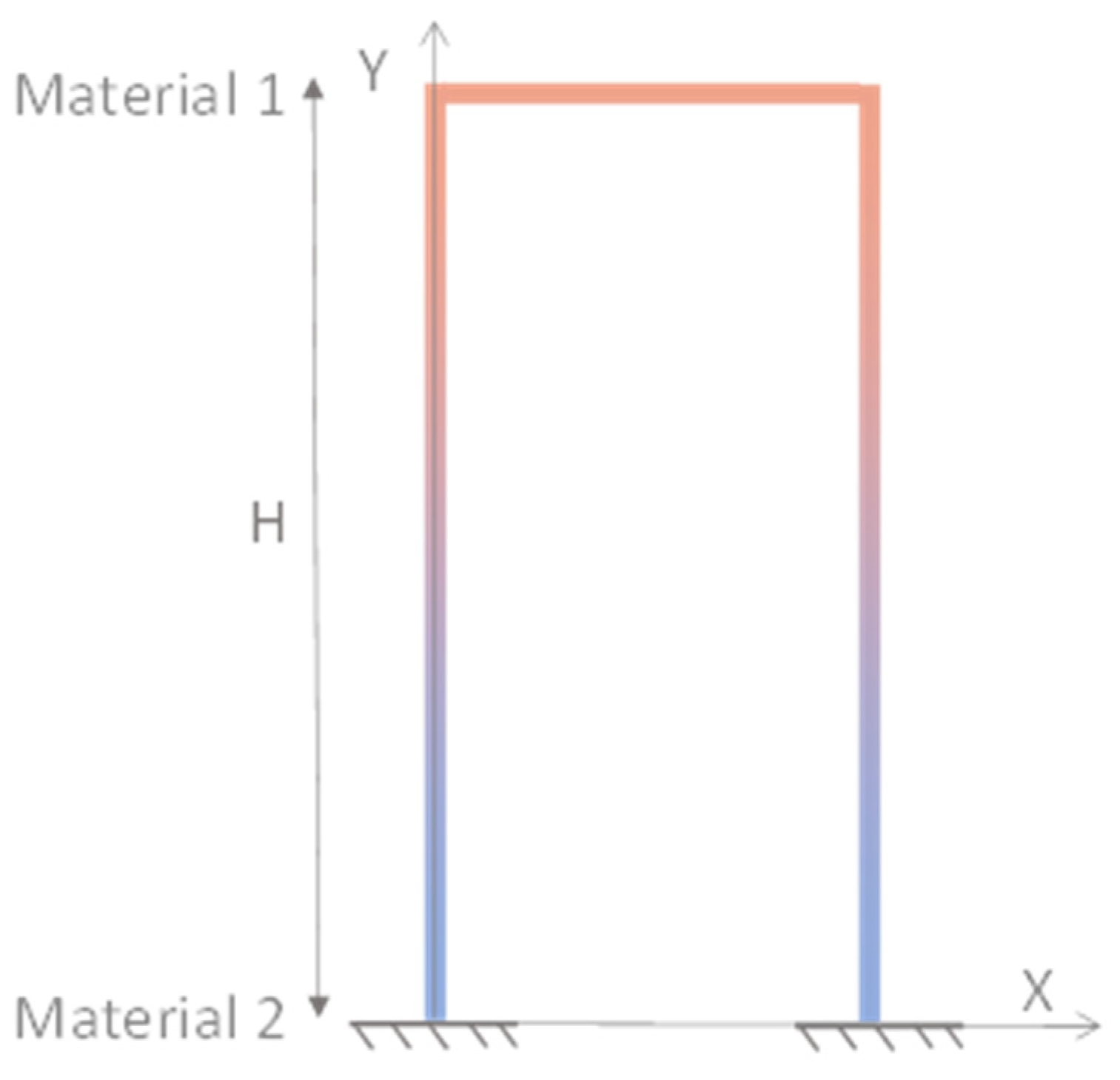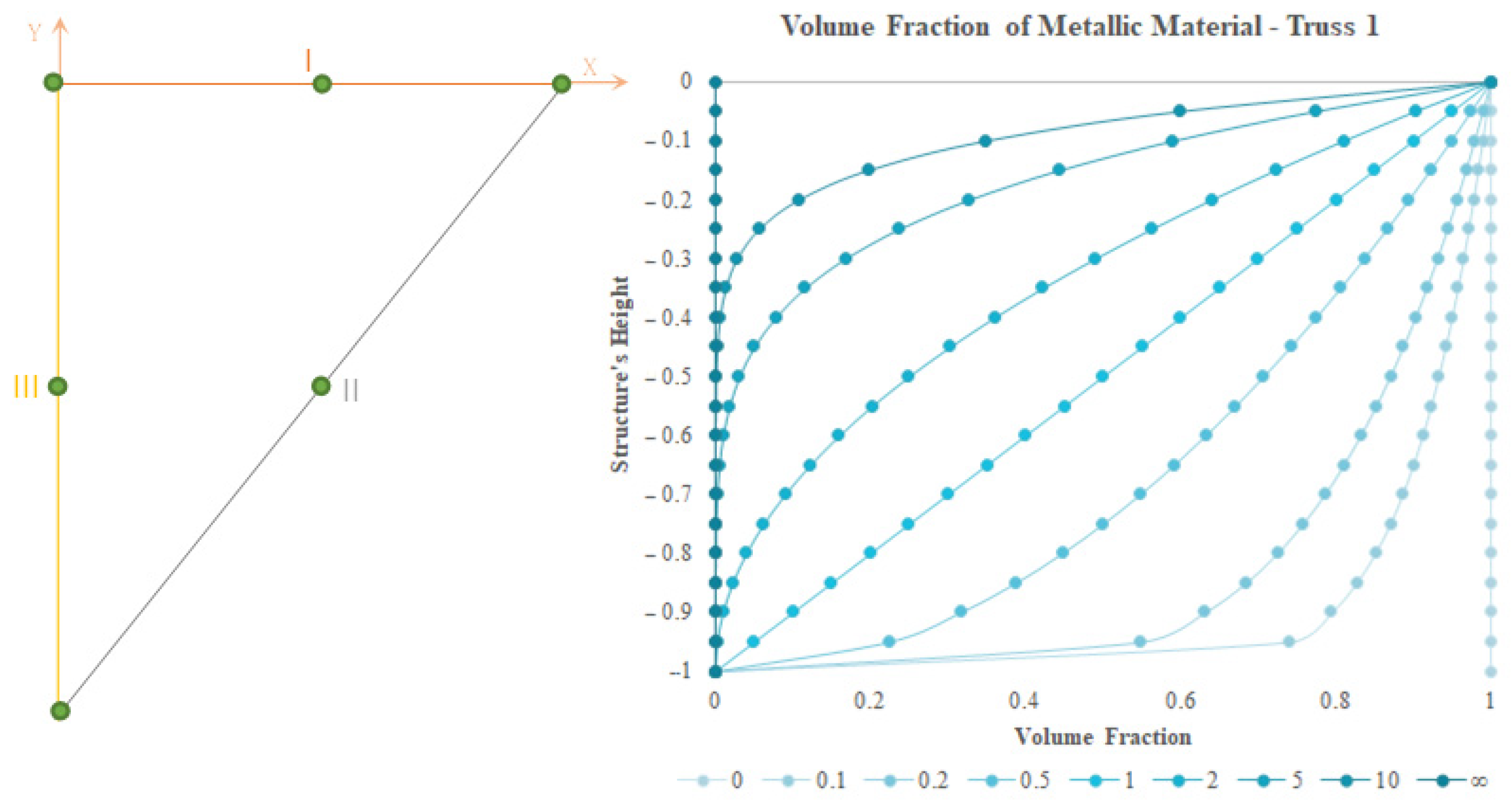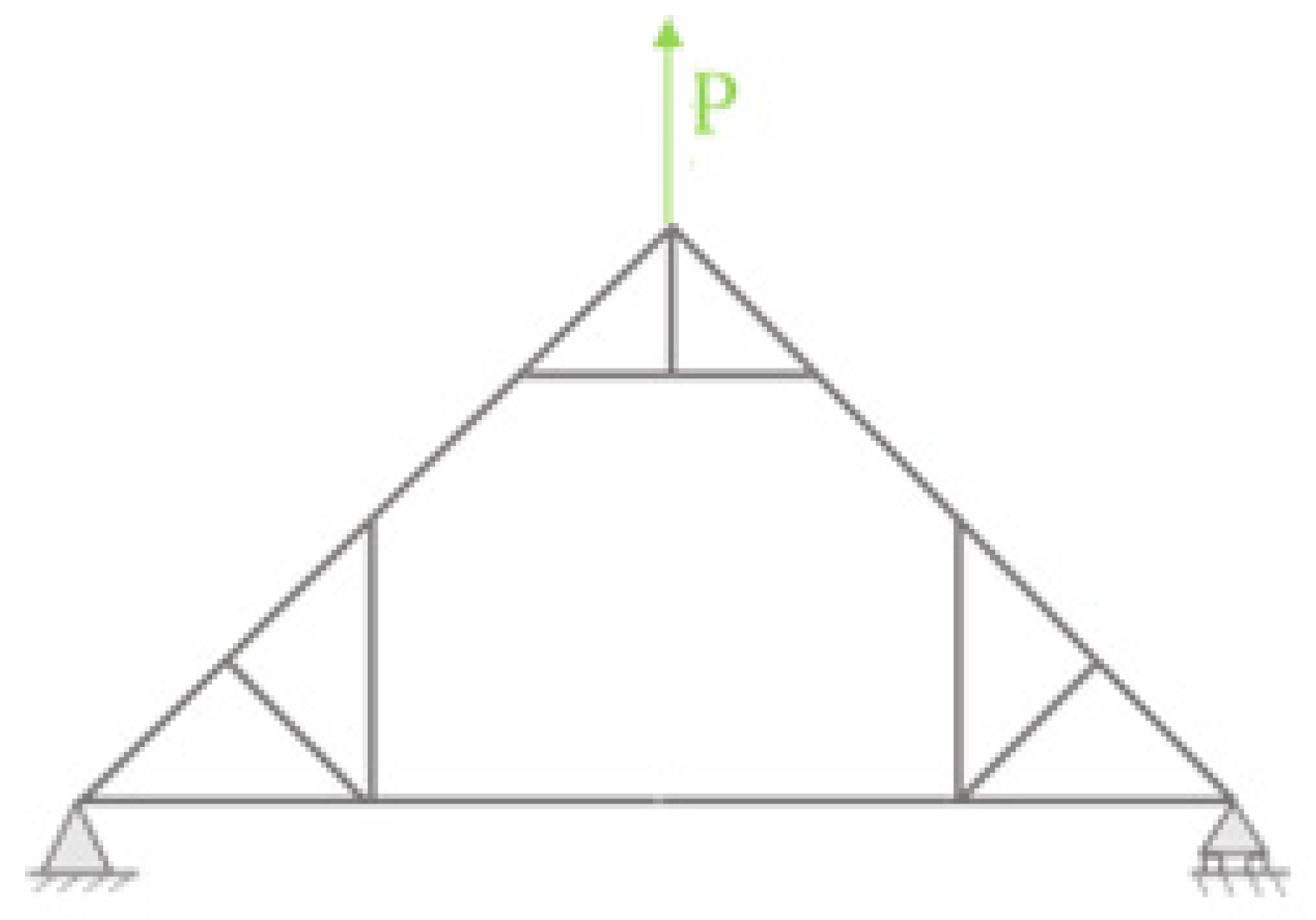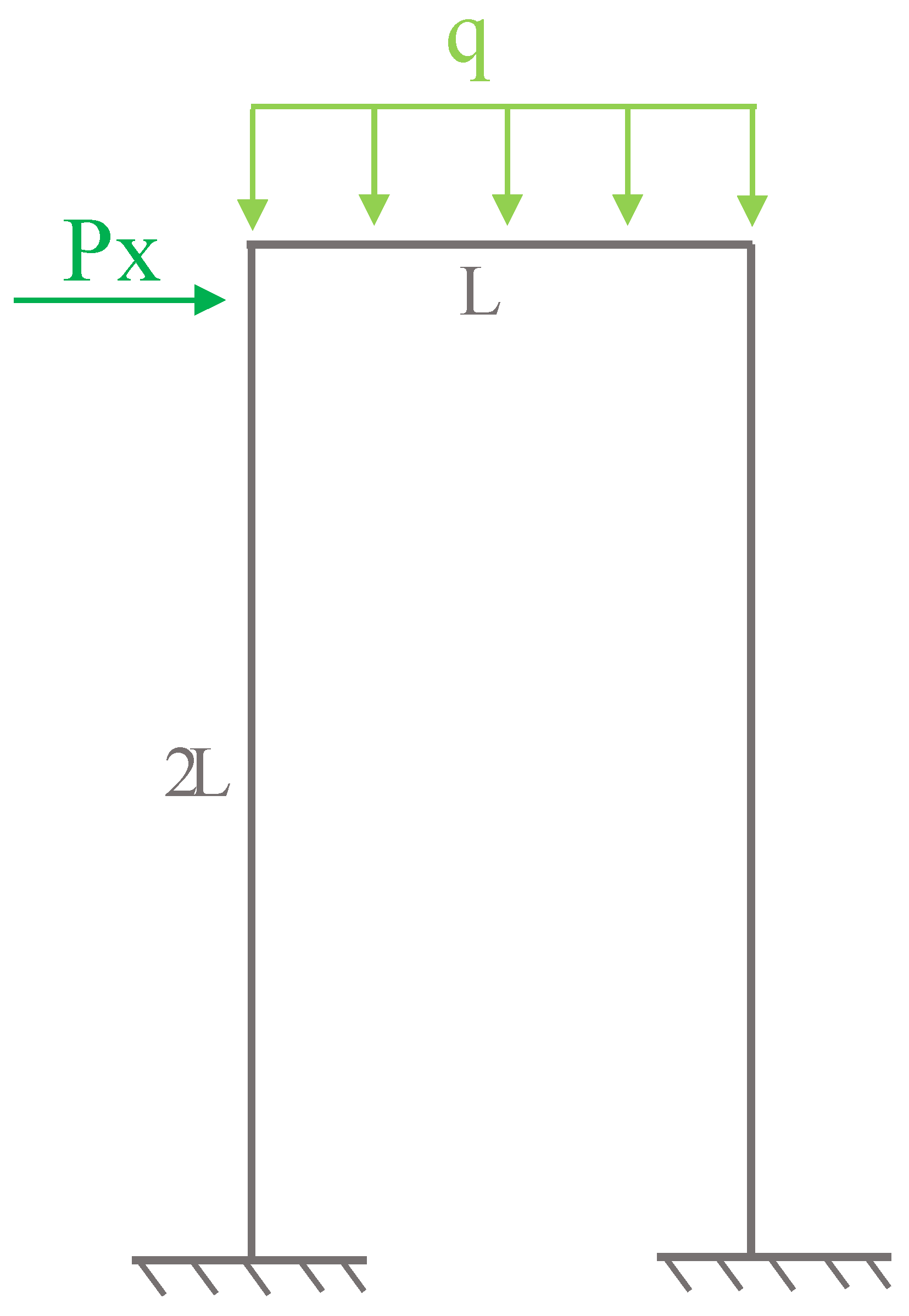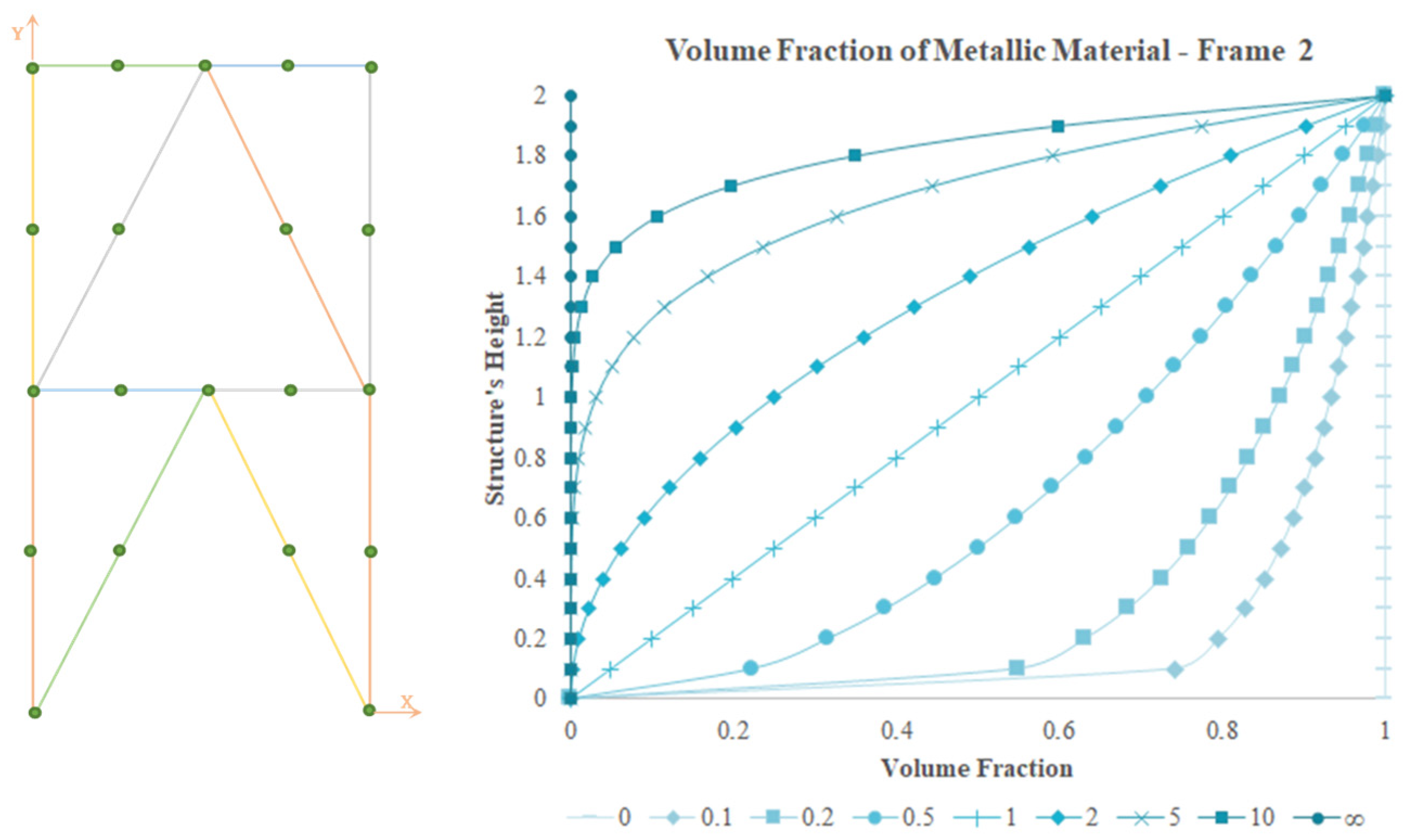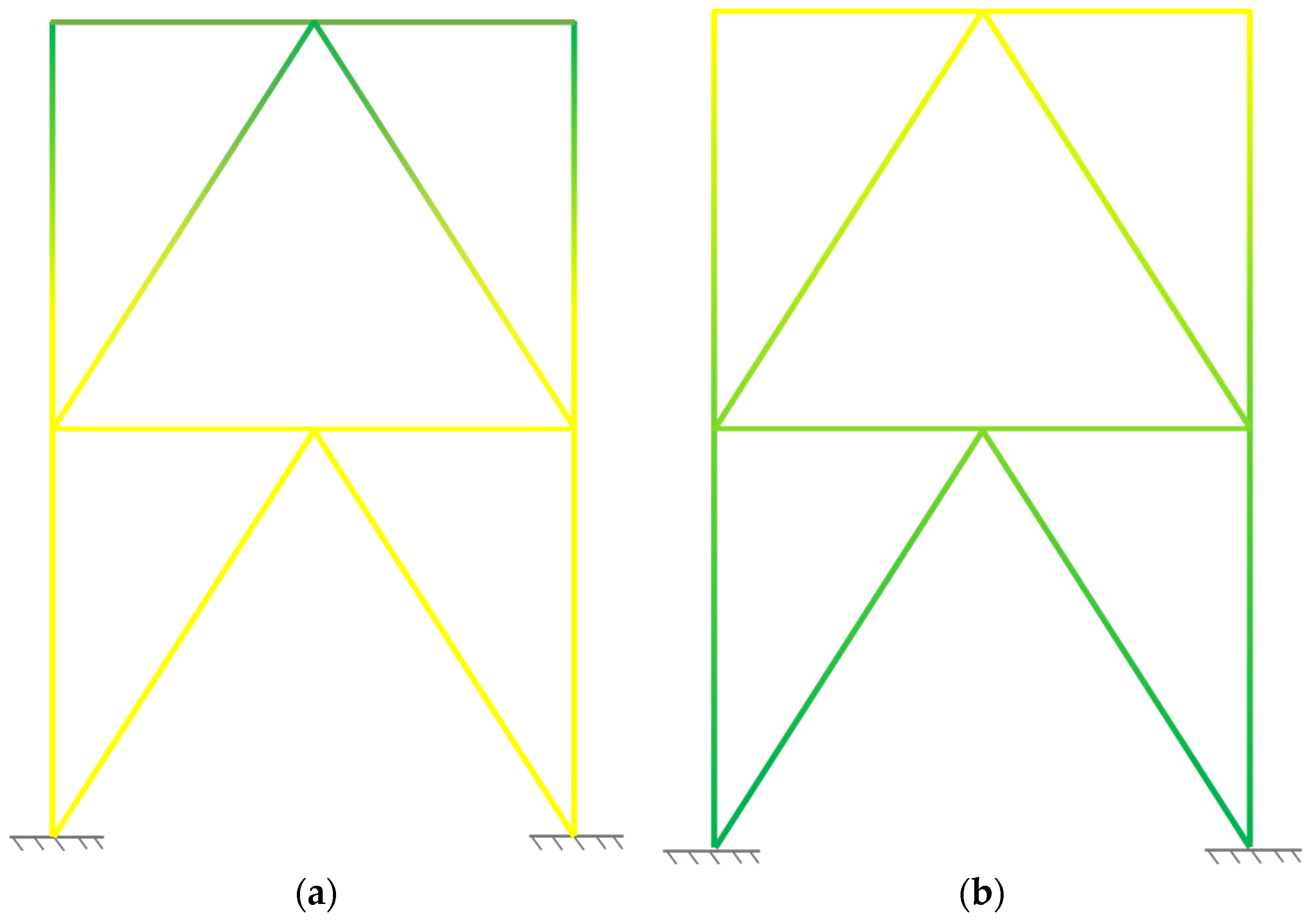1. Introduction
In engineering applications, conflicting property requirements necessitate combining materials, which can be in the molten state (or alloying), limited by thermodynamic equilibrium limits, and in the solid state, resulting in composite materials. Composite materials can be divided into laminates and functional gradients, with the latter being characterised by the minimisation of problems that occur in laminates, namely sharp interfaces between layers in which abrupt stress transitions occur and failures start [
1,
2].
Functionally graded materials are composite materials with properties that result from a combination of distinct materials in which the mixture proportions vary along one or more spatial coordinates. The improved properties of FGMs that have been achieved by using this tailoring flexibility in parallel with technological advances in manufacturing such as additive manufacturing, powder metallurgy, etc., (Kumar et al. [
3]) justify their increasingly frequent use. FGMs have wide applicability in aircraft, spacecraft, and space structures, which space exploration depends on, as well as in car parts, electronic and medical equipment, thermal coatings for ceramic engines, the marine industry, gas turbines, and biomedicine, among other applications [
4,
5,
6,
7,
8]. Although functionally graded materials still have high production costs, this type of material is a topic that has been significantly discussed by numerous authors in recent years, with many publications on the subject being published, making it a very current and important topic that should be explored further [
1,
9,
10].
To investigate the advantages of using FGMs, several authors have developed models through which static and free vibration analyses have been carried out to investigate the influence of the materials’ characteristic parameters on their behaviour. In this sense, Chi and Chung [
11] investigated elastic, rectangular, and simply supported FGM plates of medium thickness that were subjected to transverse loading. They considered constant Poisson’s ratios and varying the elasticity modulus through the plate’s thickness according to a power law, i.e., sigmoid, or exponential volume fraction function. The series solutions were obtained based on the classical plate theory and Fourier series expansion. The closed-form solutions illustrated by the Fourier series expression were given in this paper, and the closed-form and finite element solutions were compared and discussed in the second part of the study (Chi and Chung [
12]).
Reddy et al. [
13] published a review paper about the governing equations and analytical solutions of the classical and shear deformation theories of FGM beams. More specifically, the classical, first-order, and third-order shear deformation theories accounted for the through thickness variation in a dual-phase FGM and modified couple stress (i.e., strain gradient) and von Kármán nonlinearity. This study also included analytical solutions for the bending of the linear theories to illustrate the influence of material variation, boundary conditions, and loads. One of the major issues when manufacturing FGMs is the presence of porosities. Considering this, Jouneghani et al. [
14] investigated the vibrational behaviour of doubly curved shells made of FGMs, including porosities. The first-order shear deformation theory was taken as the theoretical framework, considering that the FGMs’ mechanical properties would vary through the thickness direction according to two power laws of volume fraction distribution. The strain components were established in an orthogonal curvilinear coordinate system, and the governing equations were derived according to Hamilton’s principle, and then Navier’s solution method was used; the numerical results concerning three different types of shell structures were presented. Pham et al. [
15] proposed the notion of combining the edge-based smoothed finite element method and mixed interpolation of tensorial components’ triangular element to carry out a dynamic analysis of sandwich plates with a functionally graded porous core subjected to blast load. The configuration of the sandwich plates considered a homogeneous metal bottom layer, an all-ceramic top layer, and a FGP core layer with uneven porosity distribution. The proposed element aimed to enhance the accuracy and convergence of the MITC3 element as well as the traditional triangular element. The authors performed some studies to confirm the expected performance of the proposed method and other numerical studies to characterize the vibration behaviour of the sandwich plates.
Chakraborty et al. [
16] verified that the presence of FGM layers in beams produced significantly different behaviours when compared with other beams constituted by only one of the constituent materials due to the combination of their properties. Koutoati et al. [
17] studied the stresses and strains in the interlayer interfaces of a sandwich component, and they have found that the use of FGM allows for a reduction in the presence of residual stresses, thus minimizing the occurrence of delamination and microcracking at the interfaces. In a study by Soliman et al. [
18], isotropic and orthotropic beams with functional gradient were studied, considering the variation in properties through the thickness. The results showed that the FGM beams with different power law exponents have greater resistance to distributed loads and concentrated loads when compared to isotropic and orthotropic beams for different boundary conditions and different lengths. Wang et al. [
19] investigated the dynamic behaviour of a pinned–pinned spinning exponentially functionally graded shaft with unbalanced loads. For this, they used the Rayleigh beam model, considering rotary inertia and gyroscopic effects. The model validity was confirmed, and a numerical parametric study was carried out to assess the influence of the main parameters. The results achieved led to the conclusion that the vibration and instability of the spinning shaft strongly depended on the unbalanced load and material gradient.
In a study by Zohra et al. [
20], the critical buckling temperatures and natural frequencies of beams with a thickness functional gradient were investigated, and it was observed that the effects of shear deformation on frequencies tend to be more significant when the beams become shorter (thicker). These effects were more evident for higher mode frequencies. In a study by Singh et al. [
21], it was stated that most FGMs presented material properties variation through the thickness direction and also in the axial direction, although only to a minor extent. In addition, the authors noted that the selection of a suitable material for the intended application was an immediate and direct challenge for the future development of technology in this field of research. In a study by Cao et al. [
22], there were studied beams with uniform and non-uniform cross-sections with an axially functionally graded material for different boundary conditions. In Maalawi’s study [
23], an optimisation model for improving the performance of different types of structural composites was presented, and the FGM concept was also taken into account. Several scenarios were considered to model the spatial variation in these materials’ properties. The proposed optimisation strategies included maximising natural frequencies in thin composite beams, optimising transmission shafts against torsional buckling and rotational instability, and maximising the critical flight speed of subsonic aircraft wings. Wu et al. [
24] developed a mixed finite element for the nonlinear free vibration analysis of FGM beams based on the Timoshenko beam theory under combinations of simply supported, free, and clamped edge conditions. Additionally, the finite element considered the von Kármán geometrical nonlinearity. The material properties of the beam varied through the thickness according to power-law volume fraction distributions, and the effective material properties were estimated via the rule of mixtures. A multilayer perceptron back propagation neural network was also developed to predict the nonlinear free vibration behaviour of the FGM beam.
In Katili et al.’s study [
25], it was found that, in functionally graded beams with varying properties through the thickness, the evolution of the modulus of elasticity has the greatest influence on the beam’s stress and displacement distributions. Thus, choosing the power law exponent adequately allowed the material properties to be modelled to comply with the requirements regarding the minimisation of stresses and displacements in beams. Alshorbagy et al. [
26] analysed the free vibration characteristics and dynamic behaviour of beams with variation in properties along the thickness and axial directions using the finite element method. It was verified that the variation in the material distribution along the axial direction influenced the variation in the beam stiffness along its length, hence affecting the frequencies and the respective vibration modes. However, the vibration modes were not affected by the variation in properties in thickness. This study also found that the natural frequencies increased with increasing power law exponent when the ratio between the modulus of elasticity was less than 1 and decreased otherwise.
Murin et al. [
27] presented a homogenised FGM beam finite element for modal analysis, considering a double symmetric cross-section. The element considered the shear deformation effect and the effect of longitudinally varying inertia and rotary inertia as well as a longitudinally varying Winkler elastic foundation and the influence of internal axial forces. The material effective quantities assumed a continuous variation and were determined using extended mixture rules and the multilayer method. The authors performed numerical simulations via conducting modal analyses of single FGM beams and spatial beam structures. Nguyen et al. [
28] considered the first-order shear deformation theory to carry out static and free vibration analyses of axially loaded rectangular FGM beams. Improved transverse shear stiffness was derived from the in-plane stress and equilibrium equation; thus, the associated shear correction factor was obtained analytically. The authors presented analytical solutions for simply supported FGM beams, and the results were compared with existing solutions. The influence of the power-law exponent, the dissimilarity of the constituent materials, and the Poisson’s ratio was investigated through different mechanical responses. A finite element model based on the first-order shear deformation theory for free vibration and the buckling of functionally graded beams was proposed by Kahya and Turan [
29]. The material properties varied continuously through the beam thickness according to the power-law expression, and the governing equations were derived via Lagrange’s equations. Numerical parametric studies for the natural frequencies and buckling loads were performed for different boundary conditions, power-law exponents, and span/depth ratios.
Banerjee and Ananthapuvirajah [
30] studied the free vibration behaviour of FGM beams (FGBs) and frameworks containing FGBs by using the dynamic stiffness method. In their study, it was considered that the material properties of the FGBs would vary continuously through the thickness according to a power law function. The numerical results were validated against alternative published results, and as mentioned by the authors, in the absence of published results for frameworks containing FGBs, consistency checks on the reliability of results were performed.
From our review of the literature, which has been briefly summarized in the above paragraphs, it was possible to understand that there are many studies about the behaviour of beams, plates, and even shells in FGMs; however, it was not possible to find published investigations on the behaviour of plane truss and/or frame-type structures, where the material gradient is associated with a structure dimensional characteristic, such as its height or its width.
One considers that this structure-dependent material gradient approach can be viewed as an additional design variable when dealing with such types of structures, so this was the main motivation to adopt a material gradient evolution that depends on the structure’s vertical coordinate.
The first section of the present study considers some aspects related to the development of the proposed finite element model. This is followed by a section where the model is verified for some isotropic homogeneous and FGM beams. The results achieved are then compared against alternative solutions. Afterwards, several plane truss and frame structures, are analysed and discussed.
To the authors’ knowledge, aside from the set of case studies made available for possible reproduction, there are no published works that consider this paper’s proposed approach, and this constitutes the main and innovative contribution of the present work.
4. Conclusions
From the results achieved, one can conclude that the base and the added material phases play an important role, particularly when the materials’ dissimilarity is relevant, as is the case of the materials considered in the present study. In fact, if one considers the metallic phase as the base material and the ceramic as the added one, such inclusion results in improved structure performance. On the contrary, the mixture properties will worsen and degrade the structure’s mechanical behaviour.
Overall, the nodal displacements show a decreasing trend with increasing ceramic phase quantity, which possesses a higher modulus of elasticity when compared to the metallic phase. Similarly, the natural frequencies present an opposite trend, although there is not a linear relation between frequency evolution and power law exponent progress. Specifically, in terms of the free vibration dynamic behaviour, if it is intended to maximize the fundamental frequency, it is visible that the best option for Truss 1, in terms of a functionally graded structure, is a power law exponent of 0.1, and the volume fraction is directly associated with the ceramic material. However, in this case, the all-ceramic structure enables a higher fundamental frequency. In the remaining cases, as symmetrical structures, it was noted that constructing the structures with homogeneous material is not the option that provides the best dynamic behaviour in the free vibration regime. For Truss 2, the best solution is a power law exponent of 0.1, but in this case, the volume fraction law describes the distribution of metallic material. For both Frame 1 and Frame 2, the best solution is a power law exponent of 2 and a volume fraction that describes the metallic material distribution.
The orientation of the cross-section significantly impacts the static and free vibration performance of the structures, which confirms our expectations.
Globally, the possibility of considering the variation in the materials’ mixture ruled by structure-dependent volume fraction distributions can benefit the mechanical responses of structures and contribute to tailoring them toward specific operating conditions. These additional alternative or complementary solutions may enable improved free vibration and static performances, as shown by the case studies presented in this work.


